Your cart is currently empty!
What Is Creamware Pottery? – Its Origins, History, and Uses
Published:
Last Updated:
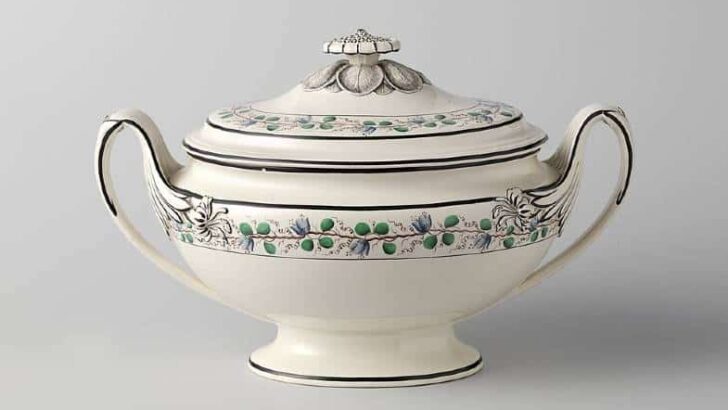
Affiliate Disclaimer
As an affiliate, we may earn a commission from qualifying purchases. We get commissions for purchases made through links on this website from Amazon and other third parties.
Creamware is earthenware pottery made from a combination of white clay and calcined flint. It is marked by a distinct cream color and a pale lead glaze. Creamware originated from England in the mid to the second half of the eighteenth century and is also linked to countries such as France, Italy, and the Netherlands.
Creamware pottery is known to be lightweight and clean, making it ideal for domestic ware. It also serves decorative purposes when made using the hand-painting and transfer-printing methods. Read on to find out more about this earthenware pottery, how it was developed, the key acts in creamware pottery, and whether or not it is still made today.
What Is the Origin of Creamware Pottery?
As mentioned above, creamware was introduced to the world by English potters, more specifically, Staffordshire potters (source). This was in about 1750, right in the middle of the eighteenth century. The discovery of creamware was a result of experiments to find a suitable replacement for Chinese porcelain.
The potters used existing techniques and materials and refined them to produce a thin, fine, and white body covered in clean lead glaze. The result, which was creamware, was deemed ideal for domestic use. Potters kept developing this pottery such that by the end of the 18th century, it had become so popular that the demand for it hit a high.
Its popularity and demand called for an increase in its supply. Thus, various factories took up the production of creamware towards the end of the eighteenth century. The Factory of Leeds, especially, became renowned for its large-scale production of creamware pottery.
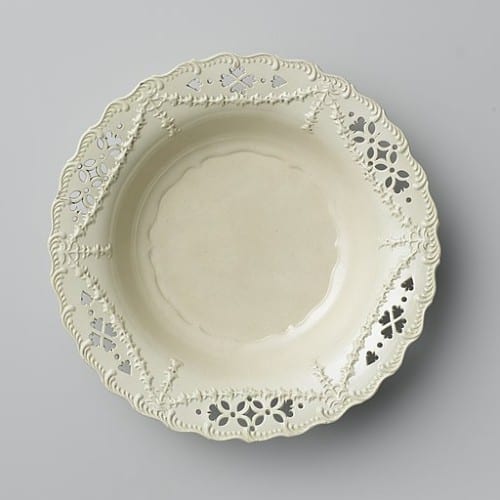
via Wikimedia Commons
How Creamware Pottery is Developed
Essentially, as we have already seen, creamware is the result of combining white clay and calcined flint and firing it at a temperature of about 800C (source). It is then glazed with lead to create cream-colored earthenware.
Note that creamware is made in much the same way as salt-glazed stoneware, with the primary difference being that the firing process of creamware is done at a lower temperature.
Salt-glazed stoneware is fired at temperatures between 1000 and 1200C. If you are interested in salt-glazed pottery, you might like to check out a post I wrote about salt-glazing here.
Originally, creamware was made by mixing lead powder of galena with calcined flint. The mixture would be dusted on the ware before being fired only once.
This method proved to be problematic as the lead mixture would poison the potters, and the process of grinding flintstones would result in the potter’s rot disease. So, the crafters had to change tactics, if only for their health.
In the 1740s, the Staffordshire potters came up with another method of developing creamware where ingredients would be mixed and ground in water to form a fluid glaze. As per this method, the ware would first be fired into a biscuit state, after which it would be glazed. The glazed mixture would then be fired one more time.
Key Creamware Potters
One of the most recognizable pioneer creamware potters was Thomas Whieldon. He was the skill and talent behind whieldon ware, otherwise referred to as tortoiseshell ware. As per the name, tortoiseshell ware is earthenware that is decorated with a dark palette to imitate a tortoise’s shell.
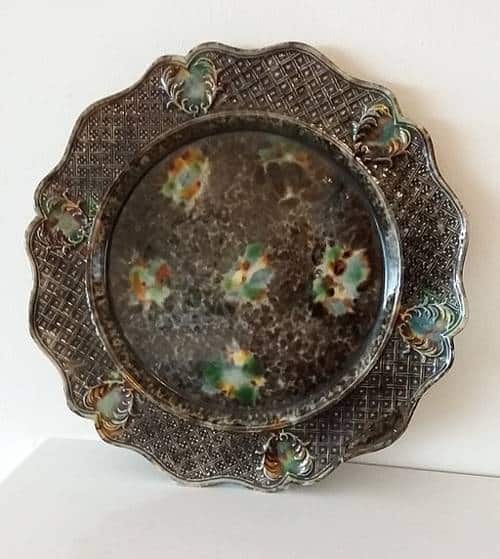
Image by JasperWare, CC BY-SA 4.0, via Wikimedia Commons
Tortoiseshell was a fashionable detail at the period, so the wares were mostly used for decoration purposes. Although Whieldon was majorly associated with tortoiseshell ware, he also made other types of creamware. One of his trademarks was to use colored stains under the glaze.
Whieldon and Wedgwood
Between 1754 to 1759, Whieldon formed a partnership with Josiah Wedgwood, who would also become a bigwig in the creamware pottery industry.
When Wedgwood left the partnership, he strived to develop the creamware craft. People would consider cream faulty as a color at the time, so Wedgwood took this in stride and introduced a more appealing bluish-white finishing in 1779. The masses greatly appreciated the finishing, and that is how pearlware came into the picture.

via Wikimedia Commons
Wedgwood worked from Burslem, and in the 1770s, Queen charlotte purchased tableware from him, which was a great honor in itself. Following this, Wedgwood sought blessings from the queen to name his creamware ‘Queen’s ware.’ For queen’s ware, Wedgwood would use a special technique called the royal pattern. Queen’s ware was, thus, among the most expensive creamware at the time.
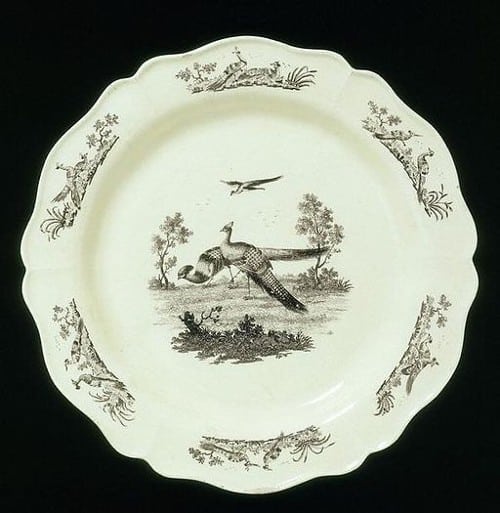
CC BY-SA 3.0, via Wikimedia Commons
The increased demand for creamware in England and other countries of the world led to immense commercial success in the industry. Not only was creamware used all over Europe, but it was also popular in the East Indies, West Indies, and various American countries.
The success of creamware led to the demise of pewter vessels and tin-glazed earthenware. As a result, major pottery factories of the time, more so factories in Leeds, took up creamware as the primary craft. Thus, the Factory of Leeds became a key player in the manufacture of creamware.
How to Identify Creamware Pottery
The easiest way to identify earthenware is through color. This is because different types of earthenware come in different colors. Generally, though, earthenware is relatively thicker and heavier than other forms of pottery.
Furthermore, earthenware has a general rustic feel and look. The following are ways through which you can identify creamware in comparison to other types of earthenware:
Creamware: Creamware stands out because of its cream color. It also exudes a creamy look, almost like light butter.
Whiteware: As per the name, this earthenware is immaculately white. Whiteware is in the ceramic in the plates you will find in stores today.
Pearlware: It is the more desirable form of creamware that Josiah Wedgwood developed in 1779. Instead of being cream, most pearlware has a blueish tint to it.
Even so, it takes time and practice to be good at identifying and differentiating various earthenware.
What is Creamware Used For?
Early on, in the mid-eighteenth century, creamware was primarily used for decoration. Potters borrowed techniques from the early porcelain industry.
One of the most used techniques was painting overglaze on the ware using pigments from fine-colored glass and firing for it to stick to the ware. That said, the decorative techniques that potters would use include the following:
Enameling
The technique was adopted from the original porcelain industry. It involves painting overglaze on the ware using pigments attained from colored glass that is finely powdered. Then, the potter would fire the ware, so the enamel fuses to the ware. Since different pigments fuse at varying temperatures, it would take more than just a few firings to fuse all of them, which could be pretty pricey at times.
Transfer-printing
This technique was developed in the eighteenth century and entailed two main methods: overglazing and underglaze. This technique involved the use of oil, where it would be poured on the ware/plate and the excess wiped off.
The impression on the ware would then be taken onto thin paper and engraved onto glazed earthenware. This technique was specialist, and experts would outsource their services and skills. For instance, Josiah Wedgwood would hire the services of transfer-printing experts from Liverpool.
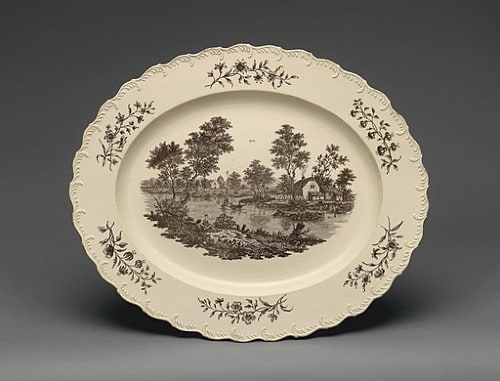
Josiah Wedgwood, CC0, via Wikimedia Commons
Tortoiseshell method
This method was mostly linked to Thomas Whieldon, as he used it in most of his craft. Hence, tortoiseshell ware is also known as Whieldon ware. This technique involved painting the biscuit surface with patches of color, after which a clear glaze would be applied. The ware would then be fired as required.
Use of lead-powder
Lead produces a brilliant transparent glaze of a rich cream color; sometimes would include small stamped motifs; dry crystals would be dusted during firing to form a design of colored patches.
Apart from decoration, creamware is also used to make plates, cups, and other types of vessels.
Is Creamware Produced Today?
Creamware was at its peak in the mid-eighteenth century, and its popularity also shone through the nineteenth century. Afterward, many substitutes were introduced in the market that dimmed down demand for this earthenware. Also, geniuses behind some of the best creamware designs, like Josiah Wedgwood, grew old and stopped practicing.
Today, most creamware pieces are kept at museums and art galleries as artifacts. However, some factories still produce it to date because the demand is just as low, although in limited quantities.
Final Thoughts
Creamware pottery is an English type of earthenware that is cream in color. It was developed in the mid-eighteenth century and was popular until the dawn of the twentieth century.
Since cream was considered a faulty color, a talented potter called Josiah Wedgwood developed pearlware, which was bluish-white, in 1779. Pearlware was relatively more desirable, leading to a high demand for it, which subsequently led to commercial success.
During the early days, creamware pottery was made for decoration purposes. After a while, though, potters began making tableware with it. Creamware vessels such as cups, plates, and jugs became common. Famous creamware potters of the time include Thomas Whieldon, the brains behind tortoiseshell ware, and Josiah Wedgwood, the man behind queens ware.
Attributions for featured image:
Wedgwood Creamware dish, Image courtesy of Rijksmuseum, CC0, via Wikimedia Commons



